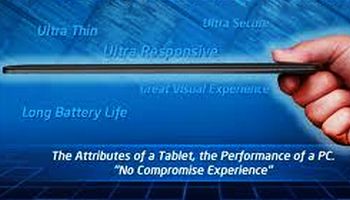Intel Targets High-End Mobility With Ultrabooks

Intel is right to push ultrabooks because it has been locked out of smartphones and tablets, says analyst
The push by Intel executives, who are investing a lot of time and money to create a new category of high-mobility computing devices called ultrabooks are on the right path, says one analyst.
This is because they have no choice, said the analyst.
Right now, the giant chip maker is essentially locked out of the booming markets for smartphones and tablets, which for the most part are powered by non-x86 chips designed by ARM Holdings and manufactured by vendors like Samsung, Nvidia, Qualcomm and Texas Instruments. Intel officials say there are x86-based tablets and smartphones on the way, but probably not until next year.
Mobile Entry
Ultrabooks are another way for Intel to establish a presence in the mobile-computing space, according to Roger Kay, principal analyst with Endpoint Technologies Associates.
“There is an enormous amount at stake in winning an important piece of mindshare for x86 architecture in the high-mobility space,” Kay wrote in an 12 August blog on Forbes. “So far, smartphones and tablets are virtually all based on ARM architecture. Intel has said it expects design wins this year for Atom-based high-mobility devices that will come to market in 2012, but for the moment, none are in market.
“Apple, which has already effectively colonised the very thin notebook space with the [MacBook] Air, bases most of its high-mobility products on ARM, has an in-house processor design team working on ARM development, and could easily cut more of its lineup over to ARM at any moment.”
 Intel needs to make its presence felt in the high-mobility market, and the ultrabook is its answer, he said. The projected numbers for tablets and smartphones tell why. Market research firm Gartner is predicting that tablet sales will grow from almost 70 million this year to 294 million in 2015. In addition, In-Stat expects 850 million smartphone sales in 2015.
Intel needs to make its presence felt in the high-mobility market, and the ultrabook is its answer, he said. The projected numbers for tablets and smartphones tell why. Market research firm Gartner is predicting that tablet sales will grow from almost 70 million this year to 294 million in 2015. In addition, In-Stat expects 850 million smartphone sales in 2015.
Meanwhile, PC sales continue to be sluggish.
Ultrabook Push
Intel executives introduced the ultrabook concept in May at the Computex 2011 show, and have aggressively pushed its agenda since. Over the past two-plus months, Intel has rolled out three new Core processors aimed specifically at the ultrabook form factor.
At the same time, the chip maker reportedly is offering financial incentives to entice OEMs to build ultrabooks, and has created reference designs to help system makers build ultrabooks that can be sold for less than $1,000 (£616). In addition, Intel Capital – the vendor’s investment arm – announced a $300 million (£185m) fund to invest in companies making hardware and software technologies for ultrabooks.
“Ultrabook devices are poised to be an important area for innovation in the $261 billion (£161bn) global computer industry,” Arvind Sodhani, president of Intel Capital and Intel executive vice president, said in a statement announcing the fund.
Intel executives are bullish on ultrabooks, which they say will combine the performance of traditional laptops and features found in tablets, including instant-on and, eventually, touch capabilities. They company is fairly specific about what defines an ultrabook.
Right Track
According to a 28 July post by Becky Emmett, media relations manager in Intel’s Global Communication Group, on the Technology@Intel blog, ultrabooks are powered by low-power Intel Core processors, are less than 0.8 inches thick, use Intel’s Rapid Start Technology to quickly get the system running, and offer battery life of five hours or more. They’ll also offer Intel security features, including Intel Anti-Theft Technology and Intel Identify Protection Technology.
A number of OEMs already are committed to building ultrabooks, including Asus, Acer, LG Electronics and Lenovo. In addition, Hewlett-Packard reportedly is working on some ultrabook models.
In his blog post, Endpoint’s Kay said that while Intel is on the right track with ultrabooks, in many ways, the ideas behind them aren’t new. In the past, there has been ultraportables, ultrathins and smartbooks, each of which had varying levels of success.
However, he said, the ultrabook concept sounds attractive.
“To date, my taxonomy of high mobility has included only smartphones and tablets, but I would open up the class to add Ultrabooks” Kay wrote. “The definition of high mobility is deliberately fuzzy. Obviously, it’s something that can be carried around easily, but beyond that, it could be anything.”